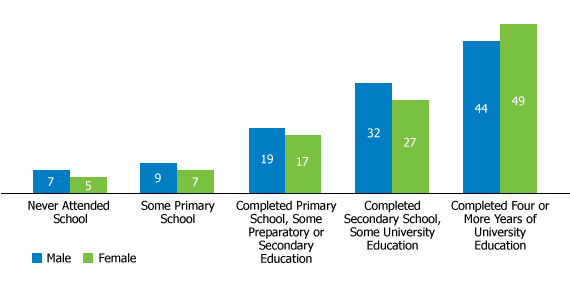
In Egypt, Young Women and People Living With HIV/AIDS Are Among the Most Disadvantaged
- This data sheet also in Arabic.
(February 2012) Jan. 25, 2012, marked the one-year anniversary of the antigovernment protests in Egypt that led to President Hosni Mubarak’s resignation. Hundreds of thousands of Egyptians, including a vast majority of young people, demanded political freedom, better wages, and better working conditions. The Egypt Youth Data Sheet: Selected Data From SYPE 2009, a collaboration between the Population Reference Bureau and the Population Council and funded by the Ford Foundation office in Cairo, has measures of status and well-being for this burgeoning young population.
Data collected by the Population Council in 2009 on the health, social, and economic well-being of young Egyptians point to their boiling frustration. Almost one-third of young men ages 15 to 29 wanted to go abroad, mainly to find a job or a better job.1 The unemployment rate among youth has been much higher than the national average—at least 90 percent of the unemployed in Egypt are youth, and youth make up 29 percent of the population.2 Unemployed young men searched for jobs for 109 weeks, on average, and still found nothing. But unemployed women spent even more time seeking jobs: 149 weeks. These numbers do not include those who had given up looking.
So it’s not surprising that the recurring rallying cry of “bread, freedom, human dignity” still resonates, especially among two extremely marginalized groups: young Egyptian women and people living with HIV/AIDS. There are over 11 million young women in Egypt, making them the largest of the marginalized groups, compared to 11,000 people who are living with HIV/AIDS (as of 2009)—the smallest yet one of the most stigmatized of these groups.3
Young women are less likely to attend school than their male counterparts, in part because a significant number of women marry at a young age and drop out of school. About one-third (29 percent) of married women ages 18 to 29 wed before turning 18. For women belonging to the lowest wealth quintile, it was 44 percent.4 Child marriage, defined by the United Nations as marriage before age 18, is not only a violation of girls’ rights, but also perpetuates a vicious cycle of poverty, low education, and high fertility. Among women ages 20 to 29 who had never been to school, 70 percent began their childbearing before age 20, compared to 27 percent for those who completed four years of university education.
Education is key to empowering women socially and economically. Young Egyptian women with a university education are 10 times more likely to be in the labor force than those who never attended school. Thirteen percent of women ages 15 to 29 reported never attending school.
Among married women who had not been to school, 17 percent had a husband who was at least 11 years older, compared to 7 percent of women who had a four-year university degree or higher.
The inherent power imbalance between the sexes in a household is reflected in these statistics. Eighty-six percent of young men and 74 percent of young women surveyed said that a wife should obtain her husband’s permission for everything. Seventy-one percent of young men and 49 percent of young women believed a girl must obey her brother even if he is younger than her.
“Dignity” has been used by young Egyptians all throughout the country’s revolution. But of the people on the margins of Egyptian society, those living with HIV/AIDS are perhaps given the least dignity. The 2009 survey showed that only 20 percent of young men and 16 percent of young women were willing to interact with a person who was HIV positive. Among women with a university education, this share was 49 percent—the highest number (see figure).
Percent of Egyptian Youth Ages 15 to 29 Who Are Willing to Interact With a Person Who Is HIV-Positive, by Sex and Education, 2009

Source: Population Council, Survey of Young People in Egypt, Final Report, 2010 (Cairo: Population Council, 2010).
As Egypt continues to transform, its youth will sustain the momentum of change. But the country’s young women and its marginalized populations are also affected by this transformation. A year later, as thousands of demonstrators gathered in Tahrir Square in Cairo to reflect on these events, urge more progress, and demand basic human rights, it is imperative that human rights include the equal treatment of marginalized populations such as young women and people living with HIV/AIDS.
Farzaneh Roudi-Fahimi is program director of the Middle East and North Africa Program at PRB. Tyjen Tsai is writer/editor at PRB.
References
- Population Council, Survey of Young People in Egypt, Final Report, 2010 (Cairo: Population Council, 2010).
- Farzaneh Roudi-Fahimi, Shereen El Feki, and Tyjen Tsai, “Youth Revolt in Egypt, a Country at the Turning Point” (February 2011), accessed at www.prb.org/Articles/2011/youth-egypt-revolt.aspx, on Feb. 3, 2012.
- The number of young women in Egypt is calculated using data from the Population Reference Bureau, 2011 World Population Data Sheet (Washington, DC: PRB, 2011) and the Population Council, Survey of Young People in Egypt; and UNAIDS, Middle East and North Africa Regional Report on AIDS, 2011 (Cairo: Joint United Nations Programme on HIV/AIDS, 2011).
- The Survey of Young People in Egypt used factor analysis based on household asset ownership and housing characteristics to construct wealth scores. Based on these wealth scores, households were divided into five wealth quintiles.
